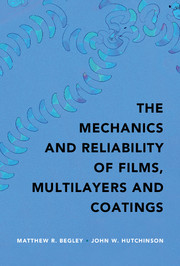Book contents
- Frontmatter
- Contents
- Acknowledgements
- Notation
- 1 Introduction
- 2 Key Mechanics Concepts
- 3 Linear Elastic Fracture Mechanics
- 4 Steady-State Delamination of Bilayers
- 5 Steady-State Delamination in Multilayers
- 6 Steady-State Channeling and Tunneling Cracks
- 7 Crack Kinking from an Interface
- 8 Crack Penetration, Deflection or Arrest?
- 9 Edge and Corner Interface Cracks
- 10 Buckling Delamination
- 11 Delamination of Thin Strips (Patterned Lines)
- 12 Delamination in Multilayers Subject to Steady-State Temperatures
- 13 Cracking under Transient Temperature Distributions
- 14 Software for Semi-Infinite Multilayers: Steady-State Delamination
- 15 Software for Semi-Infinite Multilayers: Transient Delamination
- 16 Finite Element Software for Multilayers: LayerSlayer FEA
- 17 Convergence and Benchmarks with LayerSlayer FEA
- Appendix Asymptotic Crack Tip Displacement Fields for an Interface Crack
- References
- Index
3 - Linear Elastic Fracture Mechanics
Published online by Cambridge University Press: 13 July 2017
- Frontmatter
- Contents
- Acknowledgements
- Notation
- 1 Introduction
- 2 Key Mechanics Concepts
- 3 Linear Elastic Fracture Mechanics
- 4 Steady-State Delamination of Bilayers
- 5 Steady-State Delamination in Multilayers
- 6 Steady-State Channeling and Tunneling Cracks
- 7 Crack Kinking from an Interface
- 8 Crack Penetration, Deflection or Arrest?
- 9 Edge and Corner Interface Cracks
- 10 Buckling Delamination
- 11 Delamination of Thin Strips (Patterned Lines)
- 12 Delamination in Multilayers Subject to Steady-State Temperatures
- 13 Cracking under Transient Temperature Distributions
- 14 Software for Semi-Infinite Multilayers: Steady-State Delamination
- 15 Software for Semi-Infinite Multilayers: Transient Delamination
- 16 Finite Element Software for Multilayers: LayerSlayer FEA
- 17 Convergence and Benchmarks with LayerSlayer FEA
- Appendix Asymptotic Crack Tip Displacement Fields for an Interface Crack
- References
- Index
Summary
A ‘fracture mechanics’ approach to predicting failure essentially boils down to a very simple concept: one calculates a parameter that characterizes the distribution of stresses and strains near the crack tip, and assumes that the crack will extend when this parameter reaches a critical value that depends only on the material or interface properties at hand. As one might expect, the calculated parameter will depend on the geometry of the component, the geometry of the crack, any external loads (be they mechanical or imposed temperature fields) and the constitutive law of the material (i.e., its modulus, Poisson's ratio etc.)
The power of the approach is that while the calculated parameter depends on the problem at hand, the critical value is a material or interface property that does not. The critical parameter is the toughness of the material or interface – it is measured, not predicted. Thus, one can measure the critical value of the fracture parameter in an experiment based on a convenient geometry, but assess the crack stability in a totally different geometry, provided one can calculate the intensity parameter for that geometry. The key to the enormous success of fracture mechanics is this tight connection between the experimental measurement of the critical value of the intensity parameter and the evaluation of the intensity parameter for other structural geometries and loadings of interest.
Fracture can occur in three different modes, which refer to the relative motion of the crack faces very close to the crack tip as the crack advances. These are shown in Figure 3.1; mode I is often referred to as the opening mode, mode II is typically called the shear or sliding mode, and mode III is also a shearing mode often called the tearing mode. In many problems of interest mode III (the tearing mode) does not come into play, but there are exceptions that will be discussed in later chapters. For homogenous materials with isotropic fracture behavior, the nature of the separation process at the crack tip tends to select a mode I trajectory when the crack advances, and this explains the heavy emphasis placed on mode I behavior and mode I toughness in many structural applications. However, the films, coatings and layered materials of primary interest in this book have interfaces which can greatly alter fracture behavior.
- Type
- Chapter
- Information
- Publisher: Cambridge University PressPrint publication year: 2017



